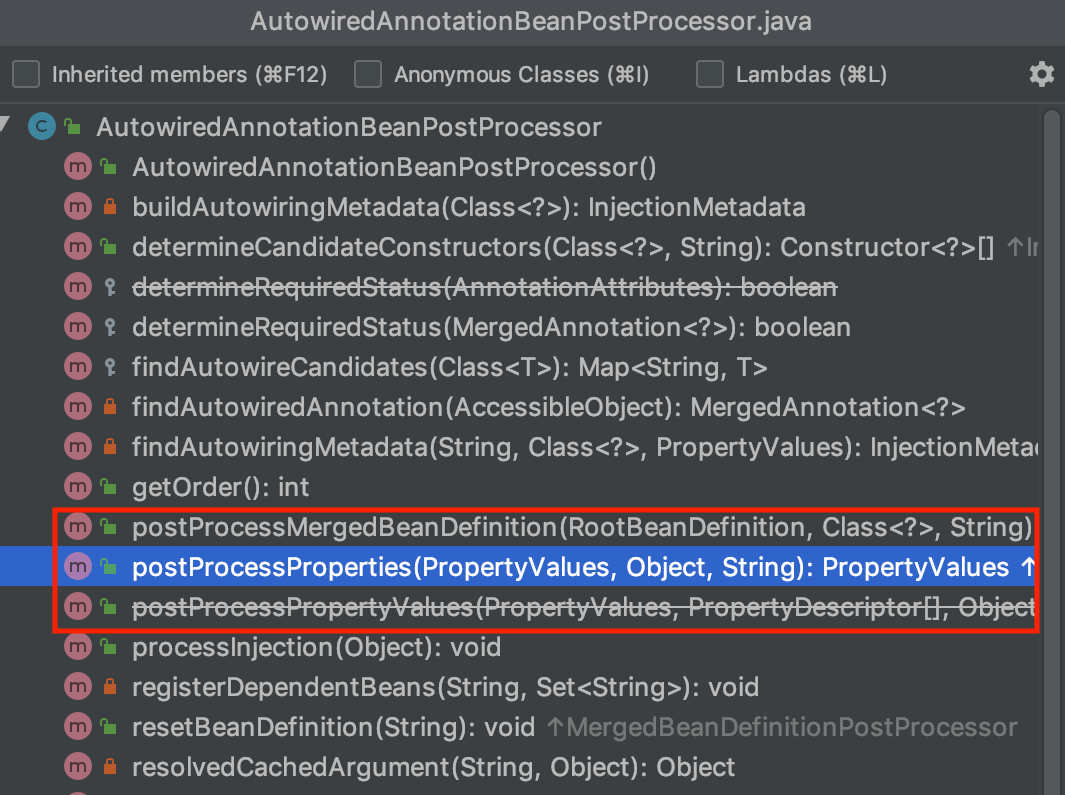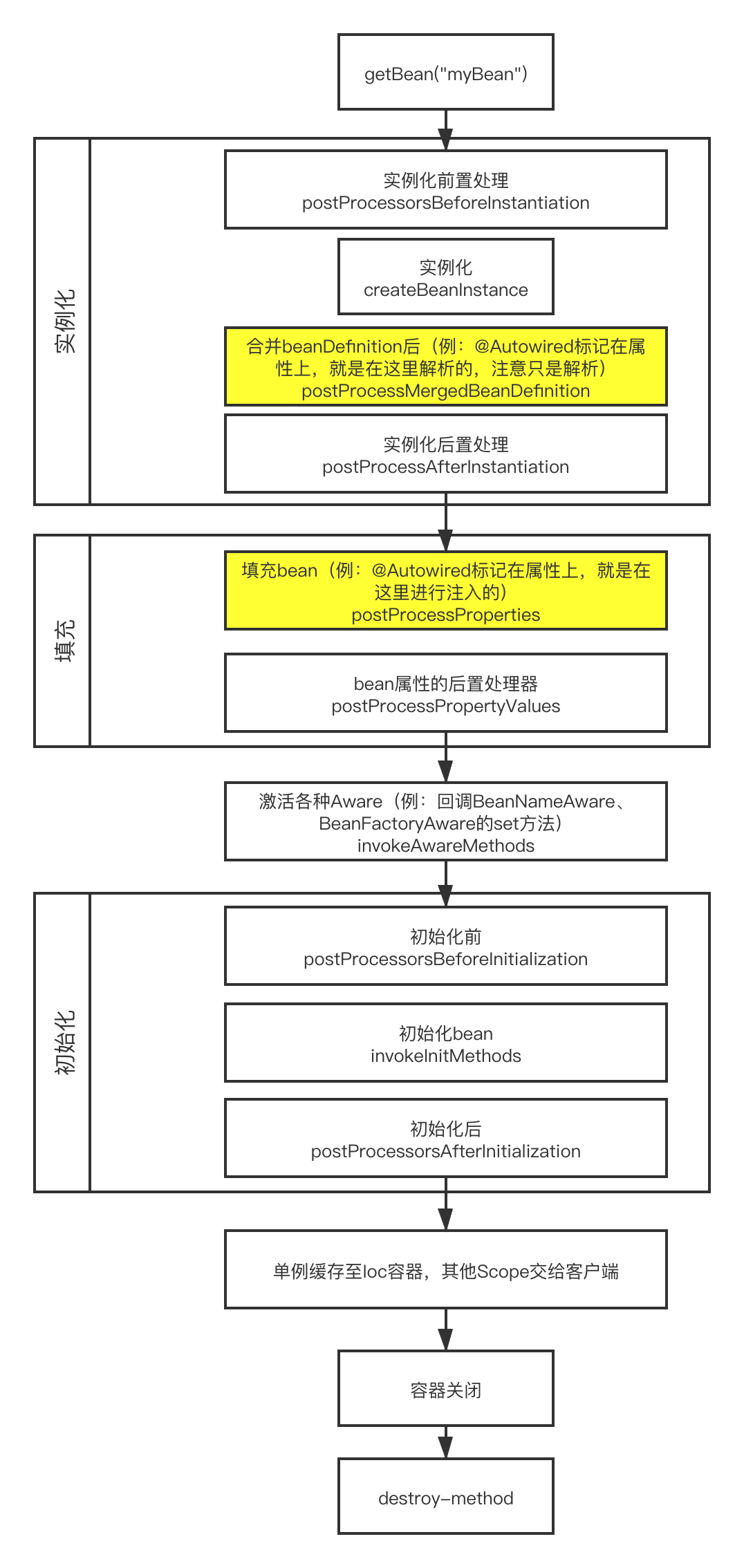您好,登录后才能下订单哦!
本篇内容主要讲解“Java的@Autowired原理是什么”,感兴趣的朋友不妨来看看。本文介绍的方法操作简单快捷,实用性强。下面就让小编来带大家学习“Java的@Autowired原理是什么”吧!
构造函数注入
public Class Outer {
private Inner inner;
@Autowired
public Outer(Inner inner) {
this.inner = inner;
}
}属性注入
public Class Outer {
@Autowired
private Inner inner;
}方法注入
public Class Outer {
private Inner inner;
public Inner getInner() {
return inner;
}
@Autowired
public void setInner(Inner inner) {
this.inner = inner;
}
}目前绝大部分的代码都使用第2、第3种。第1种在bean实例化时完成,而第2、第3种的实现原理都是一样的,在属性填充时完成。本篇将介绍第二第三种的是实现原理
在开始之前,如果我们自己设计@Autowired,我们应该怎么实现?我想做法还是比较简单的
通过反射查找bean的class下所有注解了@Autowired的字段和方法
获取到字段,通过getBean(字段)获取到对应bean,然后再通过反射调用field的set将bean注入
AutowiredAnnotationBeanPostProcessor类
该类是@Autowired的具体实现类,先预览一下类方法

发现实际有机会介入bean的创建操作只有可能是后置处理器,用于后置处理的有3个方法,其中一个过时不用,分别是postProcessMergedBeanDefinition、postProcessProperties后置处理,我们再看一下这2个方法的具体代码
public class AutowiredAnnotationBeanPostProcessor extends InstantiationAwareBeanPostProcessorAdapter
implements MergedBeanDefinitionPostProcessor, PriorityOrdered, BeanFactoryAware {
...
@Override
public void postProcessMergedBeanDefinition(RootBeanDefinition beanDefinition, Class<?> beanType, String beanName) {
// 1. 寻找bean中所有被@Autowired注释的属性,并将属性封装成InjectedElement类型
InjectionMetadata metadata = findAutowiringMetadata(beanName, beanType, null);
metadata.checkConfigMembers(beanDefinition);
}
...
@Override
public PropertyValues postProcessProperties(PropertyValues pvs, Object bean, String beanName) {
// 1. 寻找通过@Autowired注解的属性或者方法
InjectionMetadata metadata = findAutowiringMetadata(beanName, bean.getClass(), pvs);
try {
// 2. 注入
metadata.inject(bean, beanName, pvs);
}
catch (BeanCreationException ex) {
throw ex;
}
catch (Throwable ex) {
throw new BeanCreationException(beanName, "Injection of autowired dependencies failed", ex);
}
return pvs;
}
...
}跟我们的猜想是一样的,首先先找出所有注解了@Autowired的属性或者方法,然后进行注入,当然postProcessMergedBeanDefinition后置处理器的调用肯定是在postProcessProperties之前的,这里我们回顾一下spring bean的创建过程。
2个处理器我已用黄色标出

// 寻找bean中所有被@Autowired注释的属性,并将属性封装成InjectedElement类型
InjectionMetadata metadata = findAutowiringMetadata(beanName, beanType, null);
private InjectionMetadata findAutowiringMetadata(String beanName, Class<?> clazz, @Nullable PropertyValues pvs) {
// Fall back to class name as cache key, for backwards compatibility with custom callers.
// 获取缓存的key值,一般以beanName做key
String cacheKey = (StringUtils.hasLength(beanName) ? beanName : clazz.getName());
// Quick check on the concurrent map first, with minimal locking.
// 从缓存中获取metadata
InjectionMetadata metadata = this.injectionMetadataCache.get(cacheKey);
// 检测metadata是否需要更新
if (InjectionMetadata.needsRefresh(metadata, clazz)) {
synchronized (this.injectionMetadataCache) {
metadata = this.injectionMetadataCache.get(cacheKey);
if (InjectionMetadata.needsRefresh(metadata, clazz)) {
if (metadata != null) {
metadata.clear(pvs);
}
// 通过clazz类,查找所有@Autowired的属性或者方法,并封装成InjectionMetadata类型
metadata = buildAutowiringMetadata(clazz);
// 将metadata加入缓存
this.injectionMetadataCache.put(cacheKey, metadata);
}
}
}
return metadata;
}可以看到spring依然在用缓存的方式提高性能,继续跟踪核心代码buildAutowiringMetadata(clazz)
private InjectionMetadata buildAutowiringMetadata(final Class<?> clazz) {
// 查看clazz是否有Autowired注解
if (!AnnotationUtils.isCandidateClass(clazz, this.autowiredAnnotationTypes)) {
return InjectionMetadata.EMPTY;
}
// 这里需要注意AutowiredFieldElement,AutowiredMethodElement均继承了InjectionMetadata.InjectedElement
// 因此这个列表是可以保存注解的属性和被注解的方法的
List<InjectionMetadata.InjectedElement> elements = new ArrayList<>();
Class<?> targetClass = clazz;
// 1. 通过do while循环,递归的往直接继承的父类寻找@Autowired
do {
final List<InjectionMetadata.InjectedElement> currElements = new ArrayList<>();
// 2. 通过反射,获取所有属性,doWithLocalFields则是循环的对每个属性应用以下匿名方法
ReflectionUtils.doWithLocalFields(targetClass, field -> {
// 判断当前field属性是否含有@Autowired的注解
MergedAnnotation<?> ann = findAutowiredAnnotation(field);
if (ann != null) {
// 返回该属性在类中的修饰符,如果等于static常量,则抛出异常,@Autowired不允许注解在静态属性上
if (Modifier.isStatic(field.getModifiers())) {
if (logger.isInfoEnabled()) {
logger.info("Autowired annotation is not supported on static fields: " + field);
}
return;
}
// @Autowired有required属性,获取required的值,默认为true
boolean required = determineRequiredStatus(ann);
// 3. 将field封装成InjectedElement,并添加到集合中,这里用的是AutowiredFieldElement
currElements.add(new AutowiredFieldElement(field, required));
}
});
// 4. @Autowired可以注解在方法上
ReflectionUtils.doWithLocalMethods(targetClass, method -> {
Method bridgedMethod = BridgeMethodResolver.findBridgedMethod(method);
if (!BridgeMethodResolver.isVisibilityBridgeMethodPair(method, bridgedMethod)) {
return;
}
MergedAnnotation<?> ann = findAutowiredAnnotation(bridgedMethod);
if (ann != null && method.equals(ClassUtils.getMostSpecificMethod(method, clazz))) {
if (Modifier.isStatic(method.getModifiers())) {
if (logger.isInfoEnabled()) {
logger.info("Autowired annotation is not supported on static methods: " + method);
}
return;
}
if (method.getParameterCount() == 0) {
if (logger.isInfoEnabled()) {
logger.info("Autowired annotation should only be used on methods with parameters: " +
method);
}
}
boolean required = determineRequiredStatus(ann);
PropertyDescriptor pd = BeanUtils.findPropertyForMethod(bridgedMethod, clazz);
// 5. 将方法封装成InjectedElement,并添加到集合中,这里用的是AutowiredMethodElement
currElements.add(new AutowiredMethodElement(method, required, pd));
}
});
elements.addAll(0, currElements);
// 返回直接继承的父类
targetClass = targetClass.getSuperclass();
}
// 如果父类不为空则需要把父类的@Autowired属性或方法也找出
while (targetClass != null && targetClass != Object.class);
// 6. new InjectionMetadata(clazz, elements),将找到的所有的待注入属性或方法生成metadata返回
return InjectionMetadata.forElements(elements, clazz);
}外层 do … while … 的循环被用于递归的查找父类的@Autowired属性或方法
通过反射的方式获取到所有属性并循环验证每一个属性是否被@Autowired注解
将查找到包含@Autowired注解的filed封装成AutowiredFieldElement,加入到列表中
循环查找在方法上的注解
将找到的方法封装成AutowiredMethodElement,并加入列表
这里需要特别强调一点,InjectedElement被AutowiredFieldElement、AutowiredMethodElement所继承,他们都有各自的inject函数,实现各自的注入。因此改ArrayList elements是拥有2种类型的属性

将找到的所有元素列表和clazz作为参数生成metadata数据返回
// 注入
metadata.inject(bean, beanName, pvs);
public void inject(Object target, @Nullable String beanName, @Nullable PropertyValues pvs) throws Throwable {
// 获取所有需要被注入的元素
Collection<InjectedElement> checkedElements = this.checkedElements;
Collection<InjectedElement> elementsToIterate =
(checkedElements != null ? checkedElements : this.injectedElements);
// 迭代的元素不为空
if (!elementsToIterate.isEmpty()) {
for (InjectedElement element : elementsToIterate) {
if (logger.isTraceEnabled()) {
logger.trace("Processing injected element of bean '" + beanName + "': " + element);
}
// 循环注入,这里有可能是AutowiredFieldElement也可能AutowiredMethodElement,因此调用的inject是2个不同的方法
element.inject(target, beanName, pvs);
}
}
}利用for循环,遍历刚刚我们查到到的elements列表,进行注入。
在上面有特别提醒,这里的element有可能是AutowiredFieldElement类型、或AutowiredMethodElement类型。各自代表@Autowired注解在属性上、以及注解在方法上的2种不同元素。因此他们调用的element.inject(target, beanName, pvs);也是不一样的
private class AutowiredFieldElement extends InjectionMetadata.InjectedElement {
@Override
protected void inject(Object bean, @Nullable String beanName, @Nullable PropertyValues pvs) throws Throwable {
Field field = (Field) this.member;
Object value;
if (this.cached) {
value = resolvedCachedArgument(beanName, this.cachedFieldValue);
}
else {
// 专门用于注入的包装类,包装构造函数参数,方法参数或字段
DependencyDescriptor desc = new DependencyDescriptor(field, this.required);
// 设置class
desc.setContainingClass(bean.getClass());
// 需要被自动注入的beanNames,这里只有可能 = 1,方法注入时才有可能为多个
Set<String> autowiredBeanNames = new LinkedHashSet<>(1);
Assert.state(beanFactory != null, "No BeanFactory available");
TypeConverter typeConverter = beanFactory.getTypeConverter();// 获取类型转换器
try {
// 通过beanFactory获取属性对应的值,比如需要调用getBean("b")获取依赖的属性单例,并且通过自动转型转为需要的类型
value = beanFactory.resolveDependency(desc, beanName, autowiredBeanNames, typeConverter);
}
catch (BeansException ex) {
throw new UnsatisfiedDependencyException(null, beanName, new InjectionPoint(field), ex);
}
synchronized (this) {
if (!this.cached) {
if (value != null || this.required) {
this.cachedFieldValue = desc;
// 注册依赖,
registerDependentBeans(beanName, autowiredBeanNames);
// 因为是属性注入,因此这里只有可能等于1
if (autowiredBeanNames.size() == 1) {
String autowiredBeanName = autowiredBeanNames.iterator().next();
if (beanFactory.containsBean(autowiredBeanName) &&
beanFactory.isTypeMatch(autowiredBeanName, field.getType())) {
// 缓存当前value
this.cachedFieldValue = new ShortcutDependencyDescriptor(
desc, autowiredBeanName, field.getType());
}
}
}
else {
this.cachedFieldValue = null;
}
this.cached = true;
}
}
}
if (value != null) {
// 通过反射,将value值设置到bean中
ReflectionUtils.makeAccessible(field);
field.set(bean, value);
}
}
}上方大部分的工作都在做待注入bean的获取以及类型的转换,如果深究下去可以再把spring Ioc讲一遍,但是核心还是getBean(字段)获取到对应bean…我们这里就关心核心的语句,就是这2句
if (value != null) {
// 通过反射,将value值设置到bean中
ReflectionUtils.makeAccessible(field);
field.set(bean, value);
}spring通过反射的方式,调用field的set进行属性的注入
private class AutowiredMethodElement extends InjectionMetadata.InjectedElement {
@Override
protected void inject(Object bean, @Nullable String beanName, @Nullable PropertyValues pvs) throws Throwable {
if (checkPropertySkipping(pvs)) {
return;
}
// @Autowired标注在方法上
Method method = (Method) this.member;
Object[] arguments;
if (this.cached) {
// Shortcut for avoiding synchronization...
// 有缓存
arguments = resolveCachedArguments(beanName);
}
else {
// 没缓存,直接获取方法上所有的参数
int argumentCount = method.getParameterCount();
arguments = new Object[argumentCount];
DependencyDescriptor[] descriptors = new DependencyDescriptor[argumentCount];
Set<String> autowiredBeans = new LinkedHashSet<>(argumentCount);
Assert.state(beanFactory != null, "No BeanFactory available");
TypeConverter typeConverter = beanFactory.getTypeConverter();
// 循环所有参数
for (int i = 0; i < arguments.length; i++) {
MethodParameter methodParam = new MethodParameter(method, i);
DependencyDescriptor currDesc = new DependencyDescriptor(methodParam, this.required);
currDesc.setContainingClass(bean.getClass());
descriptors[i] = currDesc;
try {
// 通过beanFactory,获取代注入的bean,并进行类型转换
Object arg = beanFactory.resolveDependency(currDesc, beanName, autowiredBeans, typeConverter);
if (arg == null && !this.required) {
arguments = null;
break;
}
arguments[i] = arg;
}
catch (BeansException ex) {
throw new UnsatisfiedDependencyException(null, beanName, new InjectionPoint(methodParam), ex);
}
}
synchronized (this) {
if (!this.cached) {
if (arguments != null) {
DependencyDescriptor[] cachedMethodArguments = Arrays.copyOf(descriptors, arguments.length);
// 注册依赖
registerDependentBeans(beanName, autowiredBeans);
// 如果自动注入的个数 = 参数个数,则缓存
if (autowiredBeans.size() == argumentCount) {
Iterator<String> it = autowiredBeans.iterator();
Class<?>[] paramTypes = method.getParameterTypes();
for (int i = 0; i < paramTypes.length; i++) {
String autowiredBeanName = it.next();
if (beanFactory.containsBean(autowiredBeanName) &&
beanFactory.isTypeMatch(autowiredBeanName, paramTypes[i])) {
// 缓存
cachedMethodArguments[i] = new ShortcutDependencyDescriptor(
descriptors[i], autowiredBeanName, paramTypes[i]);
}
}
}
// 缓存方法
this.cachedMethodArguments = cachedMethodArguments;
}
else {
this.cachedMethodArguments = null;
}
this.cached = true;
}
}
}
if (arguments != null) {
try {
// 反射调用注入方法,将获取到的所有bean作为参数
ReflectionUtils.makeAccessible(method);
method.invoke(bean, arguments);
}
catch (InvocationTargetException ex) {
throw ex.getTargetException();
}
}
}
}这里与属性注入最大的区别在于,@Autowired注解在方法上,方法可以拥有多个参数,因此这里需要通过循环将一个个获取,而获取bean的方式于上面一样,本质都是通过getBean获取。
而核心语句还是2句
// 反射调用注入方法,将获取到的所有bean作为参数 ReflectionUtils.makeAccessible(method); method.invoke(bean, arguments);
与属性注入不同的是,当@Autowired注解在方法上,例如我们注解在setter方法上,则只需要直接调用该setter方法将参数数组传入即可以,即使用invoke触发方法,具体属性赋值的过程在setter方法中由用户自行编写
到此,相信大家对“Java的@Autowired原理是什么”有了更深的了解,不妨来实际操作一番吧!这里是亿速云网站,更多相关内容可以进入相关频道进行查询,关注我们,继续学习!
免责声明:本站发布的内容(图片、视频和文字)以原创、转载和分享为主,文章观点不代表本网站立场,如果涉及侵权请联系站长邮箱:is@yisu.com进行举报,并提供相关证据,一经查实,将立刻删除涉嫌侵权内容。